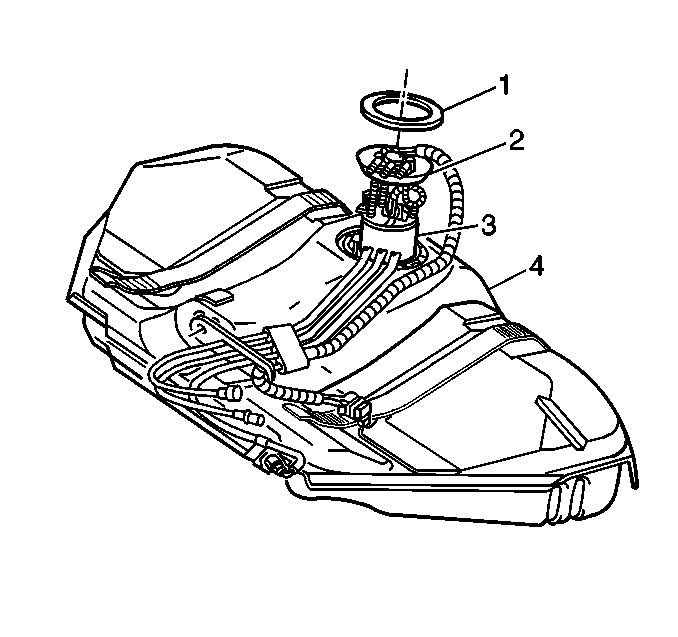For 1990-2009 cars only
Removal Procedure
Tools Required
J 39765 Fuel Sender Lock Nut Wrench
- Relieve the fuel system pressure. Refer to Fuel Pressure Relief .
- Drain the fuel tank. Refer to Fuel Tank Draining .
- Remove the fuel tank (4). Refer to Fuel Tank Replacement .
- With the J 39765 fuel sender lock nut tool, press down and rotate the cam lock ring (1) until free of the fuel sender retaining tabs.
- Remove the modular fuel sender assembly.
- Remove the fuel level sensor. Refer to Fuel Level Sensor Replacement .

Important:
• The modular fuel sender assembly may spring up from the proper
position. • When removing the modular fuel sender assembly from the fuel tank,
be aware that the reservoir is full of fuel. Tip the tank slightly during
removal to avoid damage to the float. Discard the fuel sender O-ring
and replace with a new one. • Carefully discard the reservoir fuel into an approved container.
Installation Procedure
- Install the fuel level sensor. Refer to Fuel Level Sensor Replacement .
- Install the O-ring on the fuel tank (4).
- Align the fuel lines parallel with the mark on the fuel tank.
- Slowly apply pressure to top of the spring loaded sender until the sender aligns flush with the retainer on tank.
- Install the cam lock ring using J 39765 fuel sender lock nut tool.
- Install the fuel tank. Refer to Fuel Tank Replacement .
- Lower the vehicle.
- Refill the tank and Install the fuel fill cap.
- Connect the negative battery cable. Refer to Battery Replacement in Engine Electrical.
- Inspect for fuel leaks using the following procedure:
Caution: In order to reduce the risk of fire and personal injury that may result from a fuel leak, always replace the fuel sender gasket when reinstalling the fuel sender assembly.

Important: Be sure that the cam lock ring is fully seated within the tab slots.
| 10.1. | Turn ON the ignition, for 2 seconds. |
| 10.2. | Turn OFF the ignition, for 10 seconds. |
| 10.3. | Turn ON the ignition. |
| 10.4. | Inspect for leaks. |
